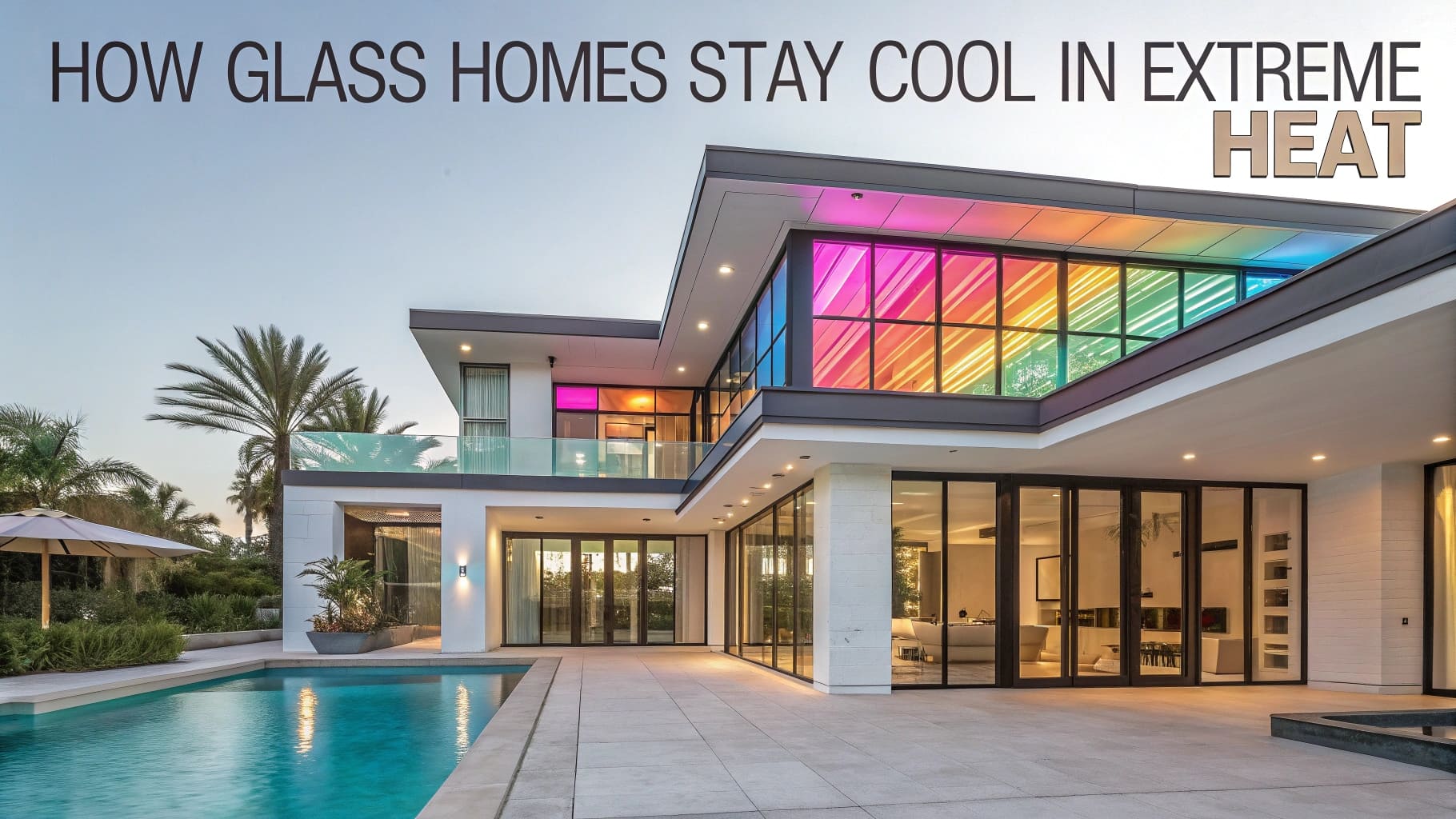Glass homes, characterized by their extensive use of glass in both structural and aesthetic capacities, have gained popularity in modern architecture. These homes often embody a seamless connection between indoor and outdoor environments, allowing natural light to flood living spaces while providing breathtaking views of the surrounding landscape. The allure of glass homes lies not only in their visual appeal but also in their ability to create a sense of openness and tranquility.
Architects and designers are increasingly drawn to the possibilities that glass offers, utilizing it to craft innovative designs that challenge traditional notions of home. However, the very features that make glass homes so desirable can also pose significant challenges, particularly in regions that experience extreme heat. The expansive glass surfaces that invite sunlight can also lead to excessive heat gain, making it essential for homeowners and builders to consider effective strategies for maintaining comfortable indoor temperatures.
As climate change continues to intensify weather patterns, understanding how to keep glass homes cool becomes paramount for ensuring both comfort and energy efficiency.
Importance of Keeping Glass Homes Cool in Extreme Heat
The importance of maintaining a comfortable temperature in glass homes during extreme heat cannot be overstated. High indoor temperatures can lead to discomfort, reduced productivity, and even health risks for occupants. Prolonged exposure to excessive heat can exacerbate existing health conditions, particularly for vulnerable populations such as the elderly or those with respiratory issues.
Moreover, the reliance on air conditioning systems to combat heat can lead to increased energy consumption, resulting in higher utility bills and a larger carbon footprint. In addition to health concerns, the structural integrity of glass homes can be compromised by extreme heat. Excessive temperatures can cause materials to expand and contract, potentially leading to issues such as warping or cracking in window frames and other structural components.
Furthermore, high indoor temperatures can create an environment conducive to mold growth and other moisture-related problems. Therefore, implementing effective cooling strategies is not only a matter of comfort but also essential for preserving the longevity and safety of the home.
Design Features for Cooling Glass Homes
Design features play a crucial role in mitigating heat gain in glass homes. One effective approach is the strategic placement of windows and glass panels to optimize natural light while minimizing direct sunlight exposure during peak hours. For instance, orienting the home to take advantage of prevailing winds can enhance cross-ventilation, allowing cooler air to flow through the space.
Additionally, incorporating overhangs or awnings can provide shade for windows, reducing the amount of solar radiation that enters the home. Another design consideration is the use of thermal mass materials within the home. Materials such as concrete or stone can absorb heat during the day and release it slowly at night, helping to regulate indoor temperatures.
By integrating these materials into the design, homeowners can create a more stable thermal environment that reduces reliance on mechanical cooling systems. Furthermore, incorporating green roofs or living walls can provide additional insulation and cooling benefits while enhancing the aesthetic appeal of the home.
Use of Insulation and Glazing for Temperature Control
Insulation and glazing are critical components in managing temperature control in glass homes. High-performance glazing options, such as low-emissivity (Low-E) glass, can significantly reduce heat transfer while still allowing ample natural light to enter the space. Low-E coatings reflect infrared light while permitting visible light to pass through, effectively minimizing heat gain without sacrificing brightness.
This technology is particularly beneficial in regions with high solar exposure, as it helps maintain a comfortable indoor climate. In addition to advanced glazing techniques, proper insulation is essential for preventing heat from infiltrating the home. Insulating window frames and using thermal breaks can enhance energy efficiency by reducing conductive heat transfer.
Furthermore, insulating walls and roofs with materials that have high R-values can help maintain a consistent indoor temperature by minimizing heat loss during cooler nights and preventing heat gain during the day. By combining effective glazing with robust insulation strategies, homeowners can create a more energy-efficient living environment that remains comfortable even in extreme heat.
Incorporating Natural Ventilation in Glass Homes
Natural ventilation is an effective strategy for cooling glass homes without relying solely on mechanical systems. By designing spaces that promote airflow, homeowners can take advantage of cooler outdoor temperatures during the evening and early morning hours. This can be achieved through the strategic placement of operable windows, skylights, and vents that facilitate cross-ventilation throughout the home.
For example, placing windows on opposite sides of a room allows for a natural flow of air as cooler breezes enter from one side and push warmer air out through the other. Additionally, incorporating clerestory windows or high-level vents can help expel hot air that rises within the space. The use of ceiling fans can further enhance this effect by circulating air and creating a wind-chill effect that makes occupants feel cooler without lowering the thermostat setting.
By harnessing natural ventilation techniques, homeowners can reduce their reliance on air conditioning while maintaining a comfortable indoor environment.
Utilizing Shading and Sun Control Devices
External Shading Devices: Blocking Sunlight Before It Reaches the Glass
External shading devices are particularly effective because they block sunlight before it reaches the glass surface, significantly reducing heat absorption. For instance, installing adjustable louvers or retractable awnings allows homeowners to control the amount of sunlight entering their homes throughout the day.
Smart Shading Solutions for Enhanced Flexibility
In addition to fixed shading solutions, sun control devices such as motorized shades or smart window films can be integrated into glass homes for enhanced flexibility. These technologies allow occupants to adjust shading based on real-time weather conditions or personal preferences.
Combining Shading Strategies for Optimal Comfort
For example, smart window films can change their properties in response to sunlight intensity, providing optimal glare reduction while maintaining visibility. By incorporating a combination of shading strategies, homeowners can effectively manage solar heat gain and create a more comfortable living environment.
Implementing Energy-Efficient Cooling Systems
While passive cooling strategies are essential for maintaining comfort in glass homes, implementing energy-efficient cooling systems is equally important for managing extreme heat effectively. Modern HVAC systems equipped with variable speed compressors and smart thermostats can optimize energy use while providing consistent cooling throughout the home. These systems adjust their output based on real-time temperature readings, ensuring that energy is not wasted when cooling is not needed.
Additionally, geothermal heating and cooling systems offer an innovative solution for temperature control in glass homes. By utilizing the stable temperatures found underground, these systems can provide efficient heating in winter and cooling in summer with minimal energy consumption. The installation of such systems may require a higher upfront investment; however, their long-term energy savings and environmental benefits make them an attractive option for homeowners seeking sustainable solutions.
Maintaining Comfort in Glass Homes during Extreme Heat
Maintaining comfort in glass homes during extreme heat involves a multifaceted approach that combines thoughtful design features with advanced technologies. By prioritizing natural ventilation, effective insulation, and strategic shading solutions, homeowners can create an environment that remains cool and inviting even on the hottest days. The integration of energy-efficient cooling systems further enhances this effort by providing reliable temperature control while minimizing energy consumption.
As climate change continues to impact weather patterns globally, understanding how to adapt glass homes for extreme heat will become increasingly important. By embracing innovative design principles and technologies, homeowners can enjoy the beauty and openness of glass architecture without sacrificing comfort or sustainability. The future of glass homes lies not only in their aesthetic appeal but also in their ability to adapt to changing environmental conditions while providing a safe and comfortable living space for occupants.
FAQs
How do glass homes stay cool in extreme heat?
Glass homes stay cool in extreme heat through the use of advanced glazing technologies, such as low-emissivity coatings and spectrally selective coatings, which help to reduce heat gain and block out harmful UV rays.
What are some design features that help glass homes stay cool in extreme heat?
Design features such as overhangs, shading devices, and natural ventilation systems are commonly used in glass homes to help reduce solar heat gain and promote airflow, keeping the interior spaces cool.
Do glass homes use energy-efficient cooling systems to stay cool in extreme heat?
Yes, glass homes often incorporate energy-efficient cooling systems, such as geothermal heat pumps, radiant cooling systems, and high-efficiency air conditioning units, to maintain comfortable indoor temperatures in extreme heat.
Are there any landscaping strategies that help glass homes stay cool in extreme heat?
Landscaping strategies, such as planting shade trees and using reflective materials for hardscaping, can help reduce the heat absorbed by the surrounding environment and minimize the impact of extreme heat on glass homes.
What role does insulation play in keeping glass homes cool in extreme heat?
Proper insulation is essential for keeping glass homes cool in extreme heat, as it helps to prevent heat transfer and maintain consistent indoor temperatures, reducing the reliance on mechanical cooling systems.

